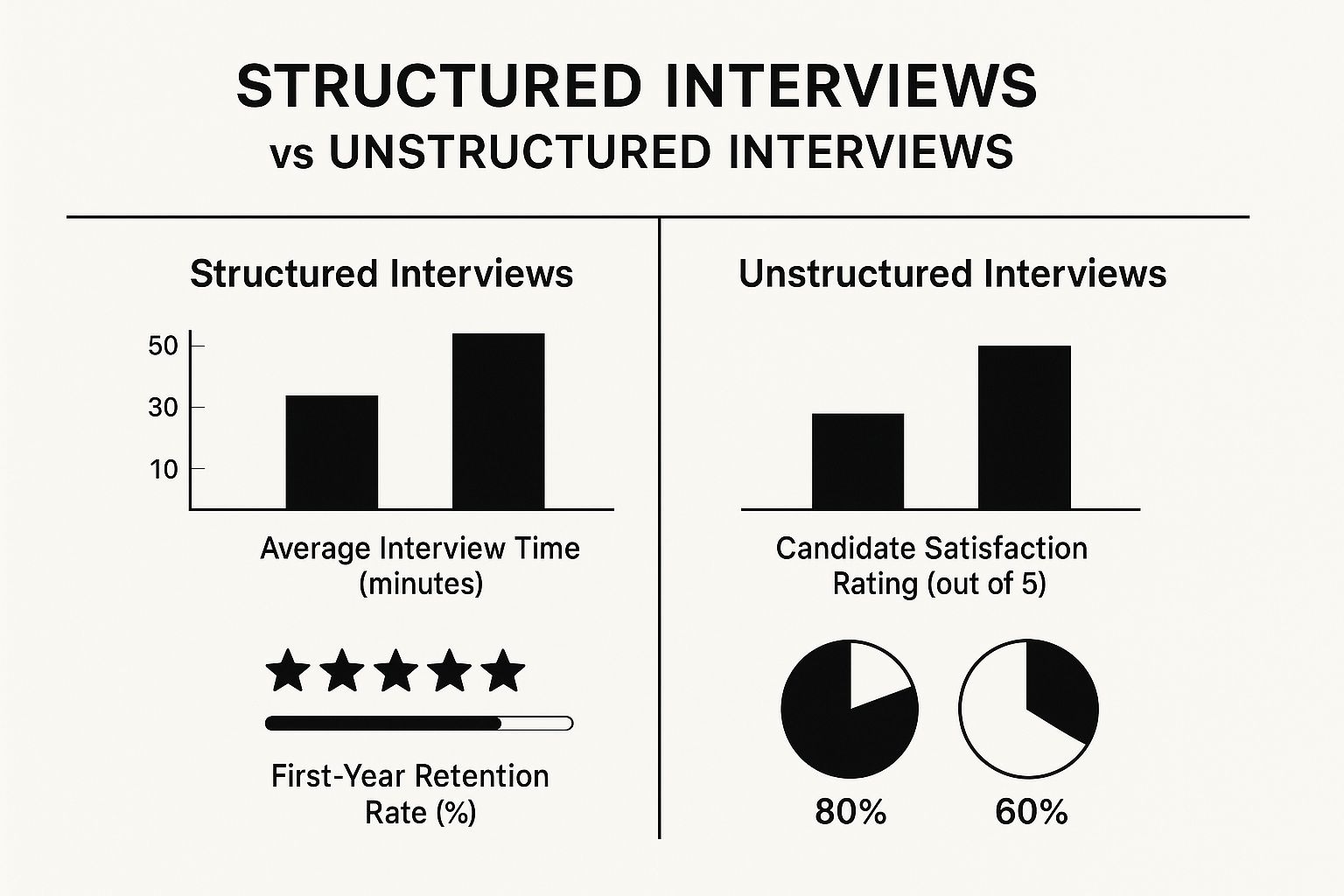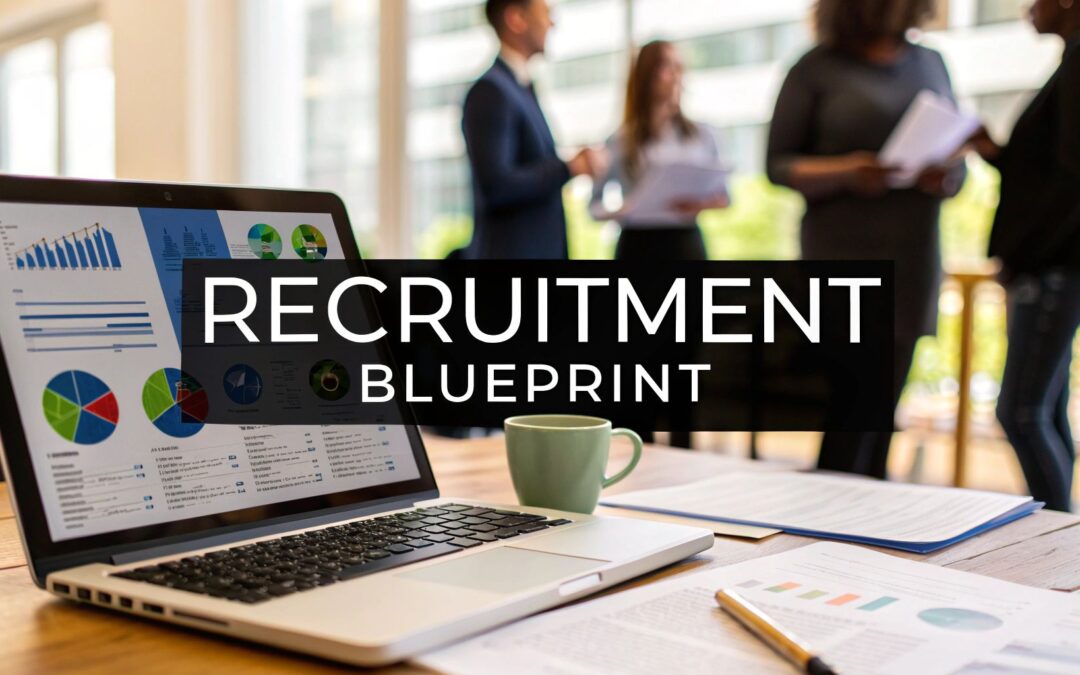A great recruitment strategy plan isn't just about filling empty seats. It's your proactive roadmap for finding, hiring, and keeping the kind of people who will drive your business forward. It's the difference between reactive hiring and building a sustainable pipeline of talent that aligns with your company's biggest goals.
Laying The Groundwork For Your Hiring Success
Before you even think about writing a job description, you have to look inward. A truly effective recruitment plan starts with a deep understanding of where your organization is today and where you want it to be tomorrow. This foundational work ensures your hiring efforts are targeted, efficient, and perfectly in sync with your company's mission.
Let's be honest, reactive hiring—that panicked scramble to fill a role after someone quits—is a recipe for disaster. It's expensive, stressful, and often results in a bad fit. Strategic workforce planning completely flips that script. You're looking ahead 12, 18, or even 24 months to predict the roles you’ll need for that upcoming product launch, market expansion, or new tech adoption. This foresight elevates recruiting from a chaotic fire drill to a calculated, strategic business function.
Conduct a Workforce and Skills Gap Analysis
Your first move is to take a hard look at your current team. What skills do you actually have in-house right now? More importantly, where are the gaps? This isn't just about coding languages or software proficiency. Think about crucial soft skills like leadership, creative problem-solving, and the ability to collaborate across departments.
A skills gap analysis might show that your engineering team is full of Python experts, but you have zero experience in machine learning—a non-negotiable for next year's product roadmap. Suddenly, you have a clear priority. This insight allows you to start searching for that specific talent long before it becomes a five-alarm fire.
Build Detailed Candidate Personas
Once you know the what (the skills you need), it's time to define the who. Candidate personas are semi-fictional profiles of your ideal hire, and they go way beyond a simple checklist of qualifications. A great persona digs into the human element.
Think about questions like:
- What really motivates this person in their career?
- What kind of work environment allows them to do their best work?
- Where do they hang out online? Which communities or blogs do they follow?
- What are their real long-term professional goals?
For example, a persona for a "Senior Data Scientist" isn't just "5+ years of experience." It’s "values autonomy to tackle complex problems, is an active contributor to open-source projects, and hangs out in Kaggle forums." This level of detail is what helps you write job descriptions and outreach messages that truly connect with the right people.
Define Your Employer Value Proposition
Your Employer Value Proposition (EVP) is your answer to the most important question every candidate has: "Why should I work for you?" It's the unique value you offer in exchange for someone's talent and time, and it has to be authentic to who you are as a company.
Your EVP isn't just about salary. It's the total experience: your culture, the opportunities for growth, your approach to work-life balance, and the chance for employees to make a real impact. It’s your promise to your people.
The best way to define your EVP? Talk to your current high-performers. Ask them what they love about working there. Their answers are the raw material for crafting a compelling and, most importantly, true message to attract more people just like them.
Set Measurable and Realistic Goals
A plan without goals is just a dream. Your recruitment strategy needs clear, measurable targets to keep you on track and prove its value. These goals can't exist in a vacuum; they must tie directly to tangible business outcomes. To build an effective recruitment strategy, adopting the latest talent acquisition best practices is essential.
Here are a few examples of what strong, data-driven recruiting goals look like:
- Time-to-Hire: Reduce our average time-to-hire from 45 days to 30 days in the next six months.
- Diversity & Inclusion: Increase the hiring of talent from underrepresented groups in our tech roles by 15% by year-end.
- Offer Acceptance: Boost the offer acceptance rate for senior roles from 75% to 90% this quarter.
- Retention: Decrease first-year turnover by 10% by improving how we match candidates to roles.
Setting concrete targets like these transforms your hiring from a guessing game into a strategic advantage, giving you clear benchmarks to measure success and show the massive impact recruiting has on the entire organization.
Finding and Attracting Your Ideal Candidates

Alright, you’ve figured out who you need. Now comes the real challenge: where and how are you going to find them? The old "post and pray" method—just throwing a job description online and hoping for the best—is a recipe for disappointment. A modern recruitment strategy plan is proactive and multi-layered, designed to meet talent where they already are.
Let's be honest, the hiring market is brutal. Talent acquisition leaders are feeling the pressure from all sides. Looking ahead to 2025, a staggering 51% of organizations say their biggest worry is turnover within their own recruitment teams. On top of that, 42% point to the sheer competition for talent as their primary hiring roadblock. This reality means you have to be smarter and faster in building your talent pipelines.
Go Beyond Traditional Job Boards
Relying solely on the big job boards is like fishing in a single, crowded pond. You’re only reaching people who are actively looking for a job. The real gold is often found with passive candidates—the skilled, experienced pros who aren't hunting for a new role but would jump at the right opportunity. To get on their radar, you need a more focused game plan.
Tools like LinkedIn Recruiter are a great starting point, letting you pinpoint people with the exact skills and experience you’re after. But don’t stop there. Put yourself in your ideal candidate's shoes. Where do they hang out online?
- Niche Communities: If you're looking for software developers, you should be active on GitHub or Stack Overflow. Hunting for designers? Behance and Dribbble are your go-to spots.
- Professional Slack/Discord Channels: These have become the new digital watercoolers for entire industries. They're incredible places to build relationships and find leads.
- Industry-Specific Forums: Every field has its own forums. By becoming a helpful, contributing member—not just a job-poster—you can build your company’s reputation from the inside out.
Build a Referral Program That Actually Works
Your best recruiters might already be on your payroll. Your current employees know your culture inside and out, and they know what it takes to thrive. A solid employee referral program can be a game-changer for finding high-quality, culture-fit candidates.
Too many companies think just offering a cash bonus is enough. The best referral programs are built on genuine employee engagement and crystal-clear communication. Make it dead simple for your team to submit a referral and keep them in the loop on its status.
Celebrate every successful referral. A public shout-out goes a long way in showing appreciation and motivating others. You could even tier your rewards, offering a bigger bonus for that hard-to-fill senior engineering role compared to an entry-level position. This nudges your team to focus on the roles that matter most.
Use Social Media to Showcase Your Culture
Candidates do their homework. Long before they ever hit "apply," they’re checking out your social media to get a feel for your company’s vibe. Use platforms like LinkedIn, Instagram, or even TikTok to put your employer brand on display and pull in the right kind of people.
Think beyond just posting job openings. Share content that tells your story.
- Employee Spotlights: Feature team members talking about what they do, how they've grown, and what they genuinely love about working there.
- Behind-the-Scenes Content: Show people what a real day is like. Post about team outings, project wins, or even the office dog. It makes your company feel human.
- Share Your Values in Action: If community service is a core value, share photos from your last team volunteer day. It’s about showing, not just telling.
For specialized roles, especially in tech, sometimes you need to call in the experts. For example, if you were hiring for niche AI skills, you might want to see how top firms handle it. It can be eye-opening to check out the top companies offering recruiting for Automated Speech Recognition services to understand how specialized sourcing is done.
Designing a Seamless and Modern Hiring Process

Attracting great candidates is only half the battle. If your hiring process is slow, confusing, or feels impersonal, all that hard work sourcing talent will be for nothing. The selection process itself is a powerful reflection of your company culture, and a clunky experience can drive away your top contenders before you even get to an offer.
Creating a modern and fair hiring workflow is a non-negotiable part of any effective recruitment strategy plan. This means building a system that is efficient for your team and respectful of a candidate's time and effort. It’s about moving with purpose and clarity from the first application to the final handshake.
Build a Structured and Fair Interview Process
Consistency is your best defense against unconscious bias and ensures every candidate gets a fair shot. An unstructured, "go-with-your-gut" interview is often a poor predictor of job performance. Instead, a structured interview process—where every candidate for a specific role is asked the same core set of questions—is the way to go.
This approach allows you to compare candidates on an even playing field, focusing on skills and experience rather than just on rapport. The key is to design questions that reveal genuine capabilities and alignment with your company's values.
Behavioral questions are especially powerful here. Instead of asking hypotheticals, you ask for real-world examples:
- "Tell me about a time you had to manage conflicting priorities. How did you decide what to tackle first?"
- "Describe a project that didn't go as planned. What did you learn from the experience?"
- "Walk me through a situation where you had to collaborate with a difficult coworker. What was the outcome?"
These questions force candidates to draw on past experiences, giving you concrete evidence of how they handle challenges, work with others, and solve problems.
Integrate Technology to Improve Efficiency
Manual candidate tracking in spreadsheets is a recipe for chaos. A modern recruiting operation needs an Applicant Tracking System (ATS) as its central nervous system, keeping everything organized, compliant, and moving forward. It’s the backbone that supports timely communication and a smooth workflow.
But technology's role is expanding far beyond simple organization. With the global recruiting market projected to reach approximately USD 642.28 billion by 2025, this growth is being fueled by new tech. Over half of all enterprises have now integrated AI into their hiring, leading to huge efficiency gains like reducing time-to-hire by nearly 50%. AI tools can automate initial resume screening and even find passive talent on alumni networks, drastically widening your candidate pool. You can learn more about how AI is shaping the recruiting market.
The best technology doesn't replace human judgment; it augments it. Use tools to handle the repetitive, high-volume tasks so your recruiters can focus on what they do best: building relationships with promising candidates.
This shift allows your team to be more strategic. It's worth exploring how different forms of business process automation can free up valuable time for your hiring managers and recruiters.
Master the Art of the Candidate Experience
Every interaction a candidate has with your company—from the moment they apply to the final email they receive—shapes their perception of your brand. A negative experience doesn't just cost you a single hire; it can damage your employer brand for years to come. In fact, 72% of candidates who have a bad experience will share it online or with their network.
Creating an outstanding candidate experience really boils down to two things: transparency and respect.
- Communicate Proactively: Never leave candidates in the dark. Acknowledge their application immediately. Let them know the general timeline for the process and provide updates, even if it's just to say there's a delay.
- Be Punctual and Prepared: Respect their time. Start interviews on schedule and make sure every interviewer has actually read the candidate's resume beforehand.
- Provide Meaningful Feedback: If a candidate makes it to the final rounds, offer constructive feedback if they aren't selected. This small act of respect can turn a rejected candidate into a future applicant or even a brand advocate.
Ultimately, a seamless hiring process is a strategic advantage. It ensures you’re not just finding top talent but also successfully guiding them through the journey, making them feel valued and excited to join your team from the very first click.
Turning New Hires into Engaged Team Members

Getting that top candidate to sign on the dotted line feels like the finish line, but it’s not. It’s actually the start of the next critical race: turning that promising hire into a genuinely engaged member of your team. This is where a killer onboarding process comes in, acting as the bridge between a great hire and a long-term, valuable employee.
Drop the ball here, and you'll pay for it. Companies with a weak onboarding game are far more likely to lose new hires within the first year. All that time and money you spent recruiting? Gone. A thoughtful, structured welcome, on the other hand, makes them feel confident they made the right choice and gets them up to speed much faster.
Building Your Onboarding Framework
Great onboarding is so much more than just a mountain of paperwork and an IT setup on day one. It's a deliberate process designed to immerse a new person in your company's world. A really solid way to think about this is through the "Four Cs" model.
Let's unpack what these look like in the real world:
- Compliance: This is the non-negotiable stuff. It’s all about teaching new hires the ground rules—think legal paperwork, security protocols, and essential company policies.
- Clarification: This is where you make sure they know exactly what's expected of them. It’s about clearly defining their role, setting performance goals, and showing them how their work contributes to the bigger picture.
- Culture: This is the secret sauce. It’s where you introduce them to your company's values, norms, and all the unwritten rules—basically, "how we do things around here."
- Connection: This might be the most important piece. It’s all about helping new hires build relationships and feel like they belong. They need to form real connections with their manager and colleagues to truly thrive.
These four pillars are designed to work together, creating an experience that supports both the practical and the personal sides of starting a new job. A strong onboarding plan gives each one the attention it deserves.
Onboarding is your first, best chance to prove that the company culture you sold during the interview process is a reality. It sets the tone for the entire employee lifecycle.
A Practical 30-60-90 Day Plan
One of the most effective tools I've seen is the 30-60-90 day plan. This simple document provides a clear roadmap for a new employee's first three months, giving them structure, measurable goals, and a real sense of accomplishment.
Here’s a quick sketch of what this could look like for a new marketing associate:
First 30 Days: All About Learning
- Get through all HR paperwork and mandatory training.
- Meet one-on-one with everyone on the marketing team to learn what they do.
- Dive deep into the company’s products and get to know the target customer inside and out.
First 60 Days: Shifting to Contribution
- Take the lead on a small-scale social media campaign.
- Jump into the team’s weekly content brainstorming sessions with ideas.
- Take full ownership of a specific weekly analytics report.
First 90 Days: Taking Ownership
- Develop and present a strategic plan for a brand-new marketing initiative.
- Independently manage a campaign from initial concept to the final report.
- Start mentoring a new intern or more junior team member.
The Power of a Buddy System
Never, ever underestimate the power of a friendly face in a new place. A formal buddy system is a surprisingly simple but incredibly powerful way to build connection and offer support from day one.
Pairing a new hire with an enthusiastic, seasoned employee gives them a go-to person for all the little questions they might feel weird asking their manager. A buddy isn't a boss; they're a guide. They can show them the ropes, from how the coffee machine works to what all the company acronyms mean. This one simple act of connection can melt away the anxiety of starting a new job and make someone feel like part of the team instantly.
How to Measure and Evolve Your Strategy
Your recruitment strategy isn't a "set it and forget it" document. Think of it as a living guide that has to grow and adapt right alongside your company and the ever-changing job market. To keep it sharp and effective, you need a constant feedback loop that's powered by both hard data and real human experiences.
This commitment to measurement is what separates a decent strategy from a truly great one. Without data, you're essentially just guessing. With it, you can make smart adjustments, prove the value of your work to leadership, and consistently hire better talent. It's the difference between flying blind and navigating with a precise GPS.
Identifying Your Core Recruitment Metrics
First things first, you have to define what success actually looks like. The best way to do that is by tracking a few essential Key Performance Indicators (KPIs). These numbers give you a clear, unbiased look at how well your hiring engine is running.
Don't get bogged down tracking dozens of data points. Start with the "big three" that give you the most bang for your buck:
- Time to Fill: This is the clock running from the moment a job is opened until an offer is accepted. If this number is creeping up, it could signal a bottleneck in your process or that you're looking for talent in the wrong places.
- Cost per Hire: This is the total investment you make—ad spend, recruiter salaries, software costs—divided by the number of people you hire. It's the bottom line on how financially efficient your strategy is.
- Quality of Hire: This is arguably the most important metric, but it’s also the trickiest to pin down. It’s usually a mix of a new hire’s performance review scores, their manager's satisfaction, and whether they’re still with the company after a year.
These metrics are the foundation of your analysis. To really get a handle on your recruitment strategy's effectiveness and make informed tweaks, you have to track the right data and analyze your key performance indicators for recruitment.
The current economic climate makes this data even more critical. Heading into 2025, the market is showing some real uncertainty. In the United States, for instance, job volume dropped 5.8% over the past three months compared to the year before. This kind of fragility makes hiring cycles longer and candidates more cautious, which means you need a razor-sharp, data-backed plan to succeed.
Turning Data into Actionable Insights
Just collecting data isn't enough. The real magic happens when you analyze it to find patterns and spot opportunities to get better. Your goal should be to move beyond just reporting numbers and start telling a story about what those numbers mean for the business. This is how you directly connect your recruiting efforts to the company's biggest goals.
Let's imagine your Time to Fill for engineering roles is consistently 20 days longer than for any other department. That's not just a statistic; it's a real problem that could be delaying a critical product launch. This single insight forces you to dig deeper. Is a slow technical screening to blame? Are your sourcing channels coming up dry? Data points you toward the right questions.
Your Dashboard is Your Strategy's Health Monitor
It doesn't need to be fancy. A simple spreadsheet or a built-in tool in your ATS can visualize your progress, helping you spot trends and share results with stakeholders in a single glance.
This infographic breaks down structured versus unstructured interviews, showing how a single process change can have a major impact on key metrics like employee retention and satisfaction.

As the data shows, structured interviews might take a bit more time upfront, but they pay off with significantly higher candidate satisfaction and a much better first-year retention rate. That’s a clear win.
Gathering Qualitative Feedback for a Full Picture
Numbers tell you the what, but qualitative feedback—the human side of the story—tells you the why. You have to listen to the people who have actually gone through your process to understand what's really happening.
Make these feedback channels a standard part of your workflow:
- Candidate Experience Surveys: After an interview, send a short, anonymous survey to every candidate, whether they got the job or not. Ask them to rate the communication, the quality of the interview, and their overall impression of the company.
- New Hire Check-ins: Schedule quick chats with new employees at the 30, 60, and 90-day marks. This is a golden opportunity to ask how the job lines up with what was discussed during the hiring process.
This blend of hard data and human feedback is at the heart of making smart, agile decisions. You can learn more about this approach by reading our guide on data-driven decision making. When you regularly review both, your recruitment strategy plan stops being a static document and becomes a dynamic system that constantly learns and improves.
Common Questions About Recruitment Strategy
Even with the best plan in hand, questions always pop up. It’s part of the process. Let's dig into a few common sticking points I see all the time, so you can sidestep them and keep your hiring on track.
How Often Should I Actually Update This Plan?
Think of your recruitment plan less like a stone tablet and more like a living, breathing document. If you just write it and file it away, it's useless.
As a baseline, you need to do a major review once a year. This is when you'll sync it up with your bigger business goals and annual budget. But don't wait a full year to look at it again.
You should be peeking at your key metrics and making small tweaks quarterly. Sometimes, things change fast—a competitor starts a hiring blitz, or a new technology disrupts your industry. When that happens, you have to be ready to pivot immediately.
What’s the Real Difference Between Recruiting and Talent Acquisition?
I get this question a lot, and it's a good one because the difference is crucial for thinking strategically. People use the terms interchangeably, but they aren't the same.
-
Recruiting is about the here and now. It’s the tactical work of filling an open job. You have a need, and you find a qualified person to fill that seat. It’s reactive and focused on a single vacancy.
-
Talent Acquisition is the long game. This is the continuous, strategic process of building relationships and creating talent pipelines for roles you will need in the future. It's proactive.
Your recruitment plan is a key part of your bigger talent acquisition strategy. One fills the immediate need, while the other ensures you're never caught off guard.
How Can My Small Business Compete With the Big Guys for Talent?
It can feel like a David vs. Goliath battle, I know. You see the massive salaries and brand names of large corporations and think, "How can I possibly compete?" But you absolutely can. You just have to play a different game.
Don't try to beat them on salary alone. Instead, lean into what makes your small business a better place to work.
Your secret weapons are usually:
- Culture and Impact: In a small company, people see the direct results of their work. They aren't just a cog in a giant machine. Make that a core part of your pitch.
- Flexibility and Autonomy: You can often offer more flexible hours or work arrangements. You can also give people real ownership of their projects, which is a huge draw for ambitious professionals.
- Real Growth Opportunities: At a smaller company, employees often get to wear multiple hats and learn directly from the founders or senior leaders. That kind of experience can fast-track a career in ways a rigid corporate ladder never could.
Your recruitment strategy needs to scream these advantages from the rooftops. Build your Employer Value Proposition around the unique, compelling story of why working with you is a better opportunity for the right person.
At Zilo AI, we know that a company is only as good as its people. Our manpower and data annotation services are built to connect you with the skilled professionals you need to scale your business and hit your goals. Let us help you find the team that will turn your vision into reality. Learn more about our services.

